My sit spot is located about 100 feet South East of the museum, and about 20-30 feet
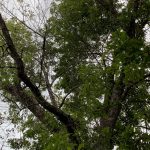
The leaves on the tree that are in view from above me, there are less leaves than a couple weeks before
South East from this gravel walkway. My sit spot is located on the hill, and if you look at a 90-degree angle to the left you can see this small tree about 30-40 feet South West of me, which has dead branches growing near the bottom of the tree. I hope that is descriptive enough for you to know where my sit spot is located. I observed many things during my quiet time. I heard many crickets chirping while I was relaxing, but I did not hear as many cicadas as I did last time which was a surprise to me, but maybe they are not as loud as they were before since it is getting colder they may be less active.
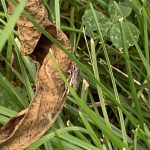
The gray insect I was talking about
I also saw an insect that looked like a baby cricket, but was a graycolor, like the color that you will see on some rocks. To me is was really beautiful because I have not seen anything like this before, and I might try to find out what species that insect was. There was some change to the three things that I am observing. First the white flowers on the tree turned into these green berries, don’t get me wrong the was some white flowers left, but most of theflowers were now berries. Also, some of the leaves on the vines have changed and they started to become brown, probably due to them dying or the change of seasons. The final change was the leaves on the trees that were starting to turn this light yellow/brownish color and are starting to fall off the tree.
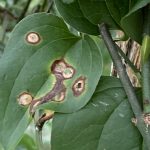
The vine’s leaves are starting to turn brown, and have holes from being eaten
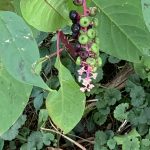
The berries on the reddish-pinkish stem.
When I was walking around my sit-spot area I saw many things. By one of the trees south of me, with the vines growing on the tree, there was this little plant with reddish-pinkish stem, with these big green leaves, with holes from being eaten by insects, and at the top they were growing these berries that were green but some were slowly turning into this dark purple color. While walking around I also saw what looked like a moth, with these beautiful white wings. I decided to observe the plant with the reddish-pinkish stem because I have never seen a plant like that before. To me it was just very interesting because you never would think that a stem of a plant would be that beautiful color. I also would want to find out if the berries growing on that plant are poisonous just out of pure curiosity.
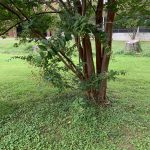
The green berries on the tree were the white flowers a couple weeks ago.
It was very interesting walking around my sit spot and seeing
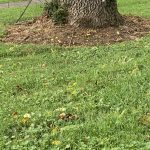
I know it is hard to see but the roots take a lot of area, so for this tree since there is abundant water they can grow more shoots.
things more in depth, because to me it was very fun. I loved seeing the vines up close, and I also went up to the tree with the white flowers, now berries, to see what the tree looked like. I don’t know the plant species, but I saw that the bark was a light brown color, and that it was smooth looking, not like most bark. Walking around let me get to know the area more, and I was also happy to see that one plant with the reddish-pinkish stems, because I have not noticed that plant before. There isn’t anything else that I want to do after walking around the sit spot, because most of my curiosity was answered.

The plant with the reddish-pinkish stem
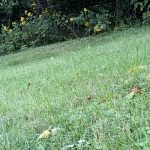
Verbesina Occidentalis growing outwards to get some sun since the trees above them block alot of the sunlight
At first it was hard to see some adaptations, but I did find three adaptations that stuck out to me. First the trees that are by my sit spots had roots that covered a lot of area and did not seem to be too deep. That is probably because since Virginia gets a lot of precipitation they do not need to make their roots deeper in order to obtain water. Another adaptation that I noticed was that the vines that were growing on the trees South of me were facing a certain direction. I think that they were facing the direction, where the leaves are sticking out in order to get more sunlight. The last adaptation that I noticed, was that the Verbesina Occidentalis that is growing at the edge of the forest is drooping South West so that they can get some sunlight, because the trees in the forest shade a lot of area, so the stems have to stick out farther in order to get more sunlight.

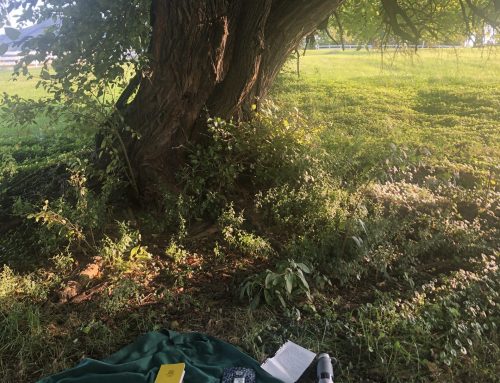
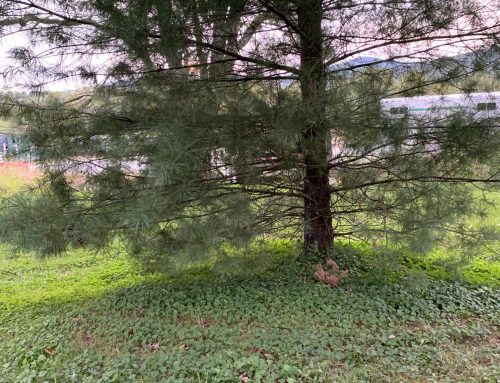
It seems like you had much to explore on your walk around your sit spot in terms of insects and plants! The first adaptation that you mentioned is a pretty cool one that I had never really recognized before. There probably is a reason behind why some tree’s roots protrude more than other and it is possible that this is related to precipitation levels.
Hi Aliya,
your sit-spot seems to be full of insects, plants, and vegetation. I think it is so cool at how the white flowers have now turned into berries. The fall weather brings out the beauty and some plants, and as for some, brings the “uglier” side of plants which is sad. It is cool how the plant grew out from under the tree to reach sunlight. It is so neat how these plants and animals adapt/grow in order to adjust to their circumstances. I look forward to following your journey on the blog posts.